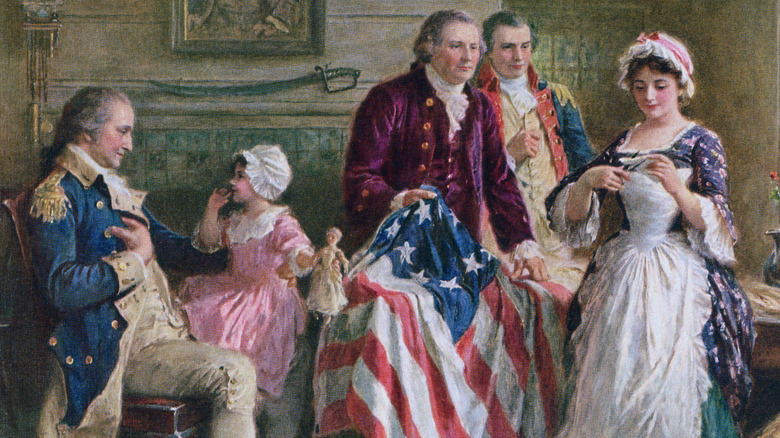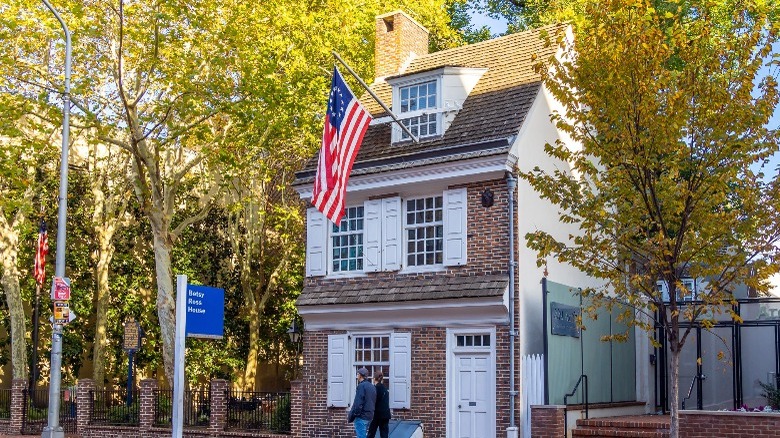How Many Husbands Did Betsy Ross Have?
Betsy Ross is best remembered for her skills as a seamstress during the Revolutionary War, and legend has it that she helped to create the first American flag (via Britannica). As the story goes, General George Washington visited Ross, an upholsterer in Philadelphia, in 1776 or 1777 to have a flag made for the new nation, per History. She reportedly made the suggestion to change stars used in Washington's design from six-pointed stars to five-pointed stars. Her role in the making of the first "Stars and Stripes" flag didn't come to light until nearly a century later, thanks to a pamphlet written by her grandson. (Some have questioned the veracity of this story.)
What is known to be true about Ross makes for a fascinating tale in its own right, whether or not she made that first flag. Her life provides a glimpse into the personal struggles and challenges people faced during America Revolution. Ross found love three times during her life, and she experienced countless heartbreaks along the way.
Betsy Ross eloped with her first husband
The woman who became known as Betsy Ross started out as Elizabeth Griscom, born on January 1, 1752, according to Britannica. She was a part of a large family, one of 17 children born to Samuel and Rebecca Griscom (via Historic Philadelphia). A talented carpenter, Samuel moved his family to Philadelphia when Betsy was still small. Her family were deeply committed to their Quaker faith, and she was educated at a Quaker school. Betsy became an apprentice to an upholsterer, and it was through work that she met her first love.
Betsy fell for a fellow apprentice named John Ross, but her family didn't approve, since he wasn't a Quaker. The couple ran off together and got married in 1773, which led to her being expelled from her faith, per History. The couple set up their own upholstery business in Philadelphia, and her husband joined a local militia to support the revolutionary cause. Sadly, he died in 1776, leaving Betsy a widow. It is around this time that Betsy may have met with General George Washington to work on America's first flag.
Betsy Ross's second husband was captured at sea
Ross, a 24-year-old widow, continued to work as an upholsterer after her first husband's death, per Historic Philadelphia. One of her known projects from this time was making flags for the navy. In June 1777, she married her second husband, Joseph Ashburn. The couple had two daughters together, but sadly one of the girls didn't live to see her first birthday. Her husband was a sailor and often worked away at sea.
Ashburn was aboard a merchant marine ship that was captured by the British in 1781. He and the rest of the crew were imprisoned on treason charges, and they served their time at the Old Mill Prison in Plymouth, England. Unfortunately, Ashburn's health took a turn for the worse while being bars. An unknown illness took his life in May of 1782, and only a few weeks later the British released their American war prisoners. One prisoner, John Claypoole, was a friend of Ashburn, and visited with Ross when he returned to Philadelphia (via Britannica).
Betsy married for a third and final time
Ross and Claypoole soon became romantically involved, and the pair tied the knot in 1783, according to the National Women's History Museum. The couple had five daughters during their long marriage. Not long after she married for the third time, Ross joined the Free Quakers, a group of believers who had been expelled by those of her original faith. Free Quakers rejected taking the traditional Quaker stance of pacifism when it came to the American Revolution (via Historic Philadelphia).
Around 1800, Claypoole had some type of health setback. Ross's handiwork remained in demand and she continued to run her business with help from her daughters, per History. They made six giant flags in 1810 to be used by garrisons in New Orleans, and they made nearly 30 flags for the Indian Department. After years of being in poor health, Claypoole died in 1817. Ross did not let loss stop her from her work, but she did eventually begin to lose her eyesight. This vision problem probably prompted her retirement at the age of 76. The thrice-widowed Ross died in 1836 at the home of one of her daughters in Philadelphia. She has been remembered as one of the leading female patriots for her efforts in support of the American Revolution.



